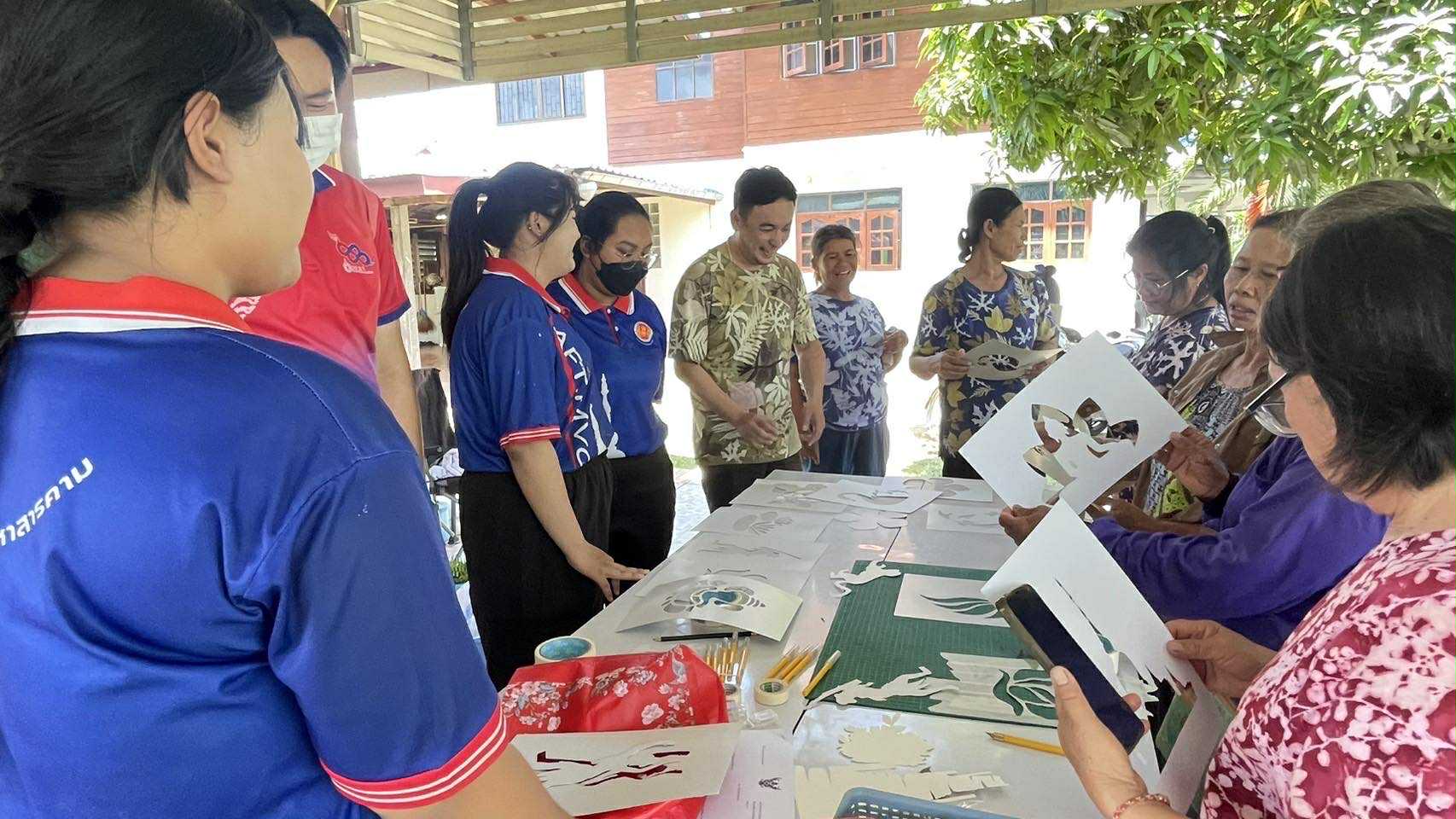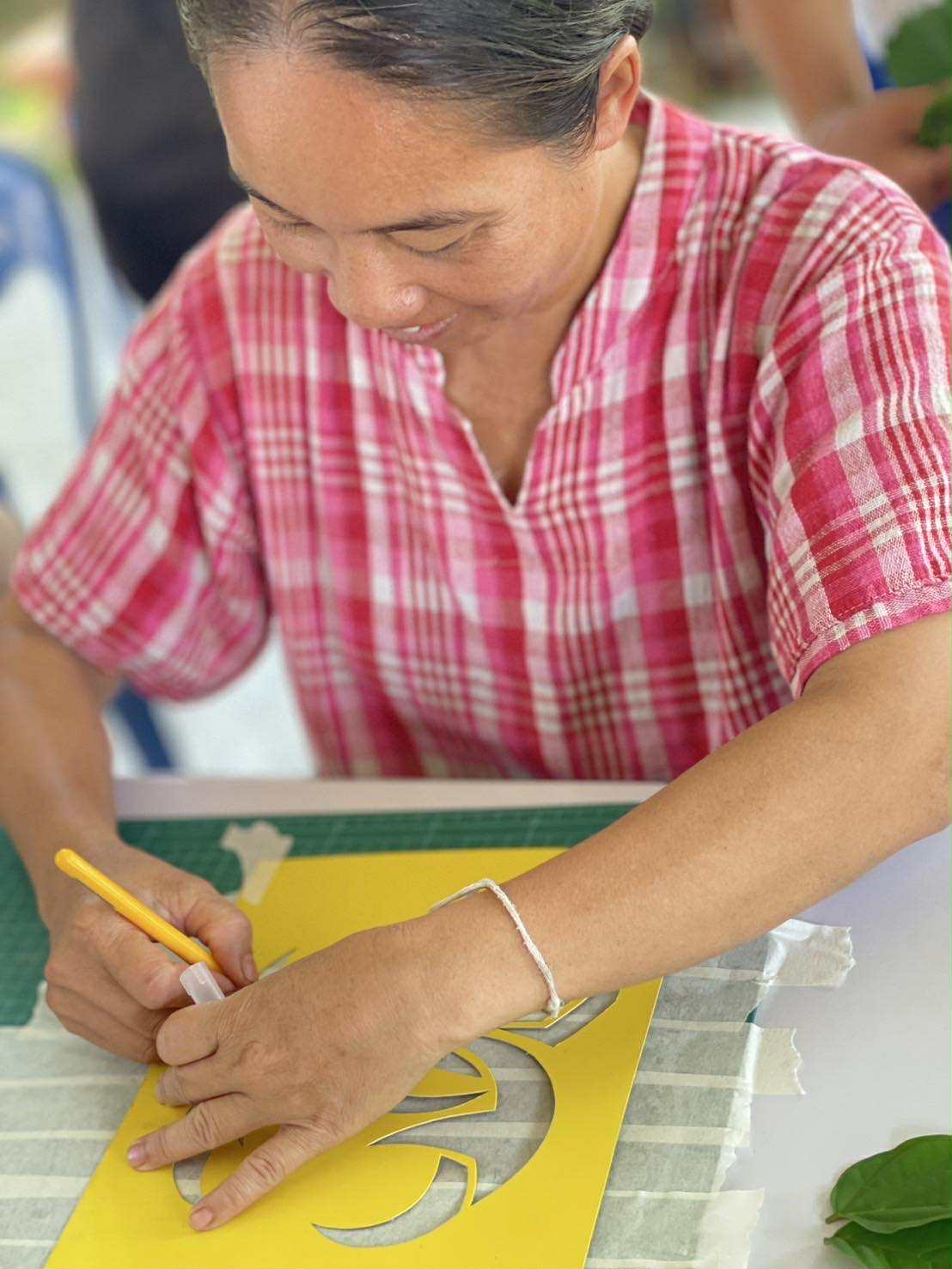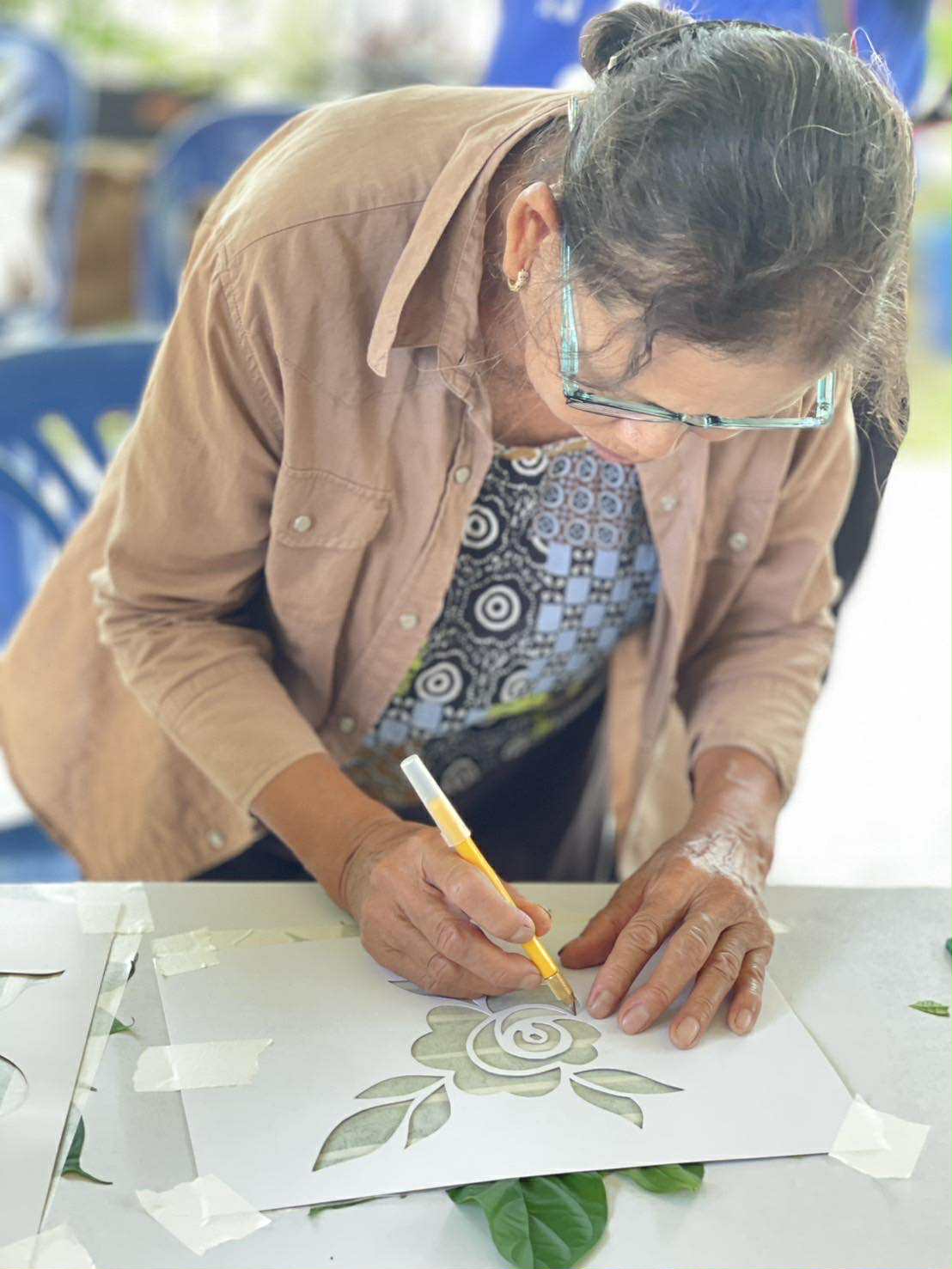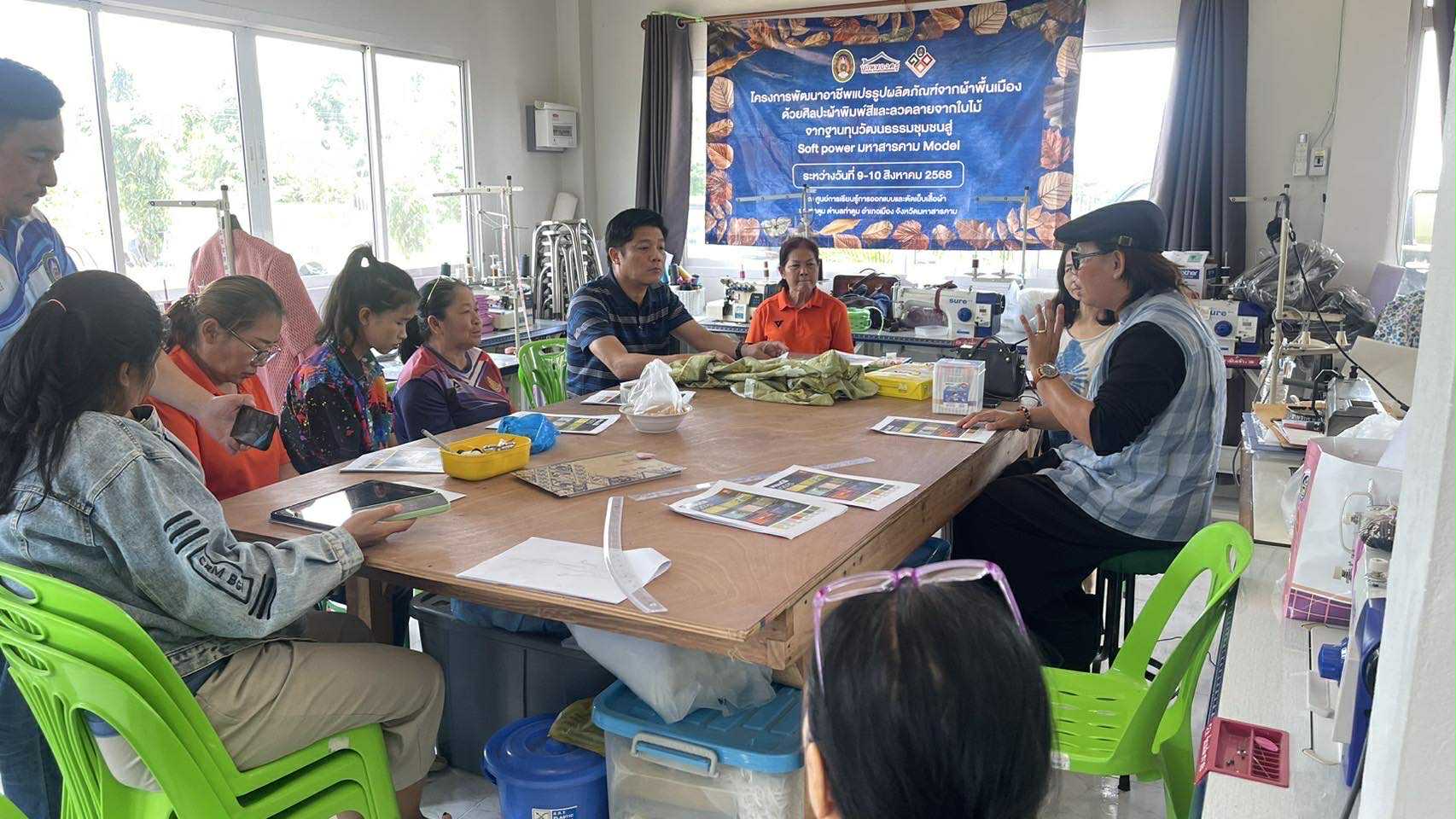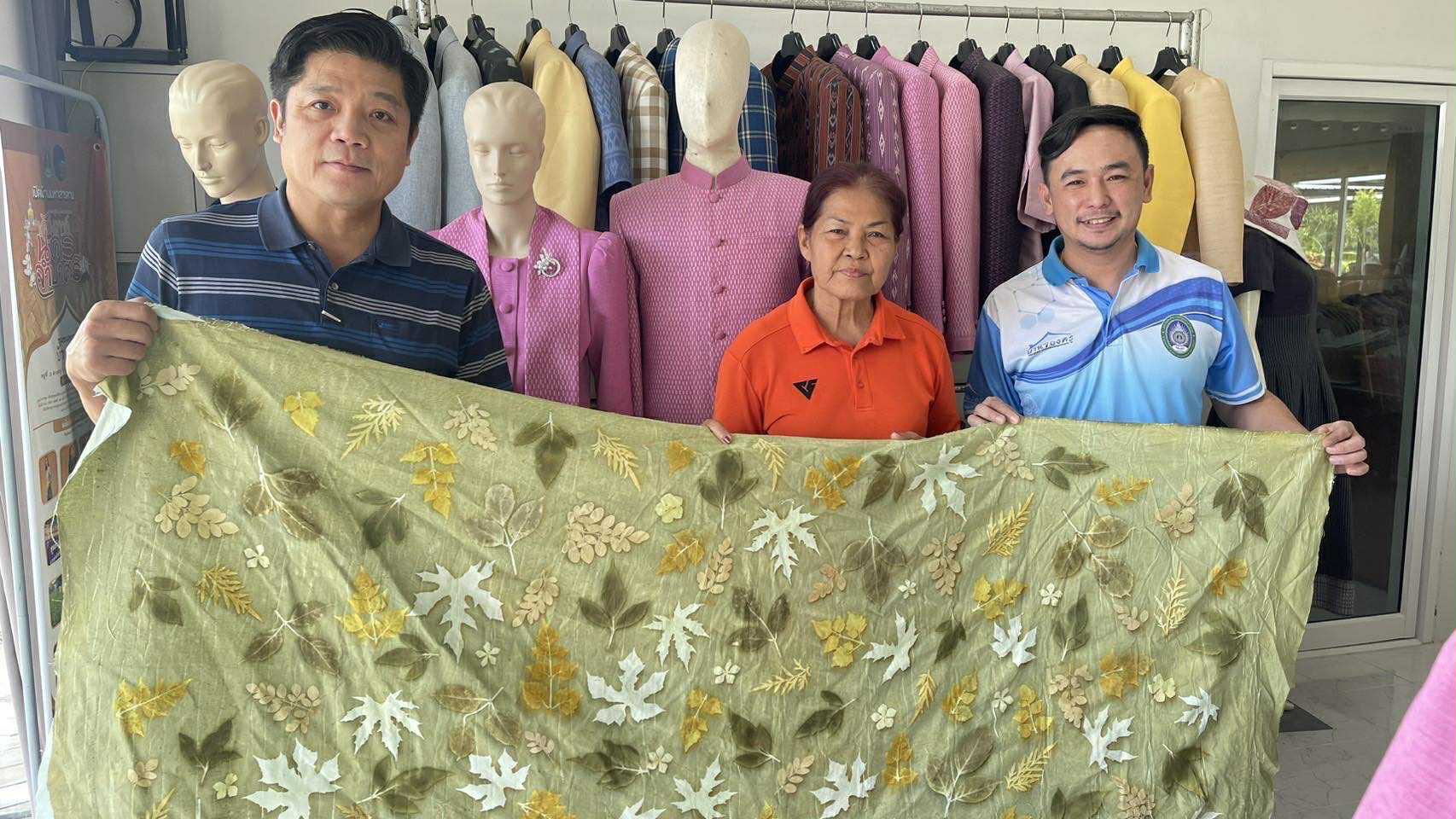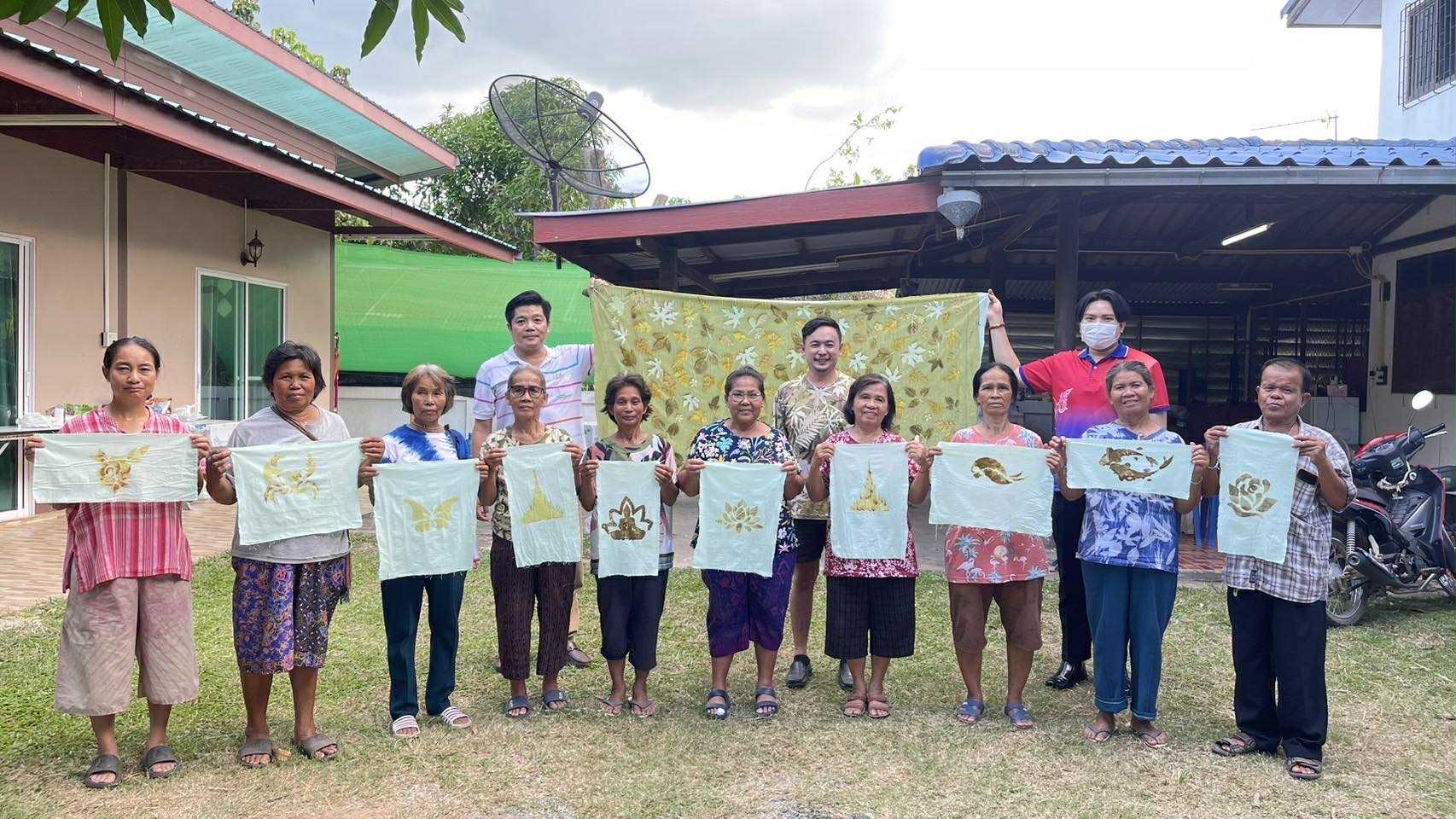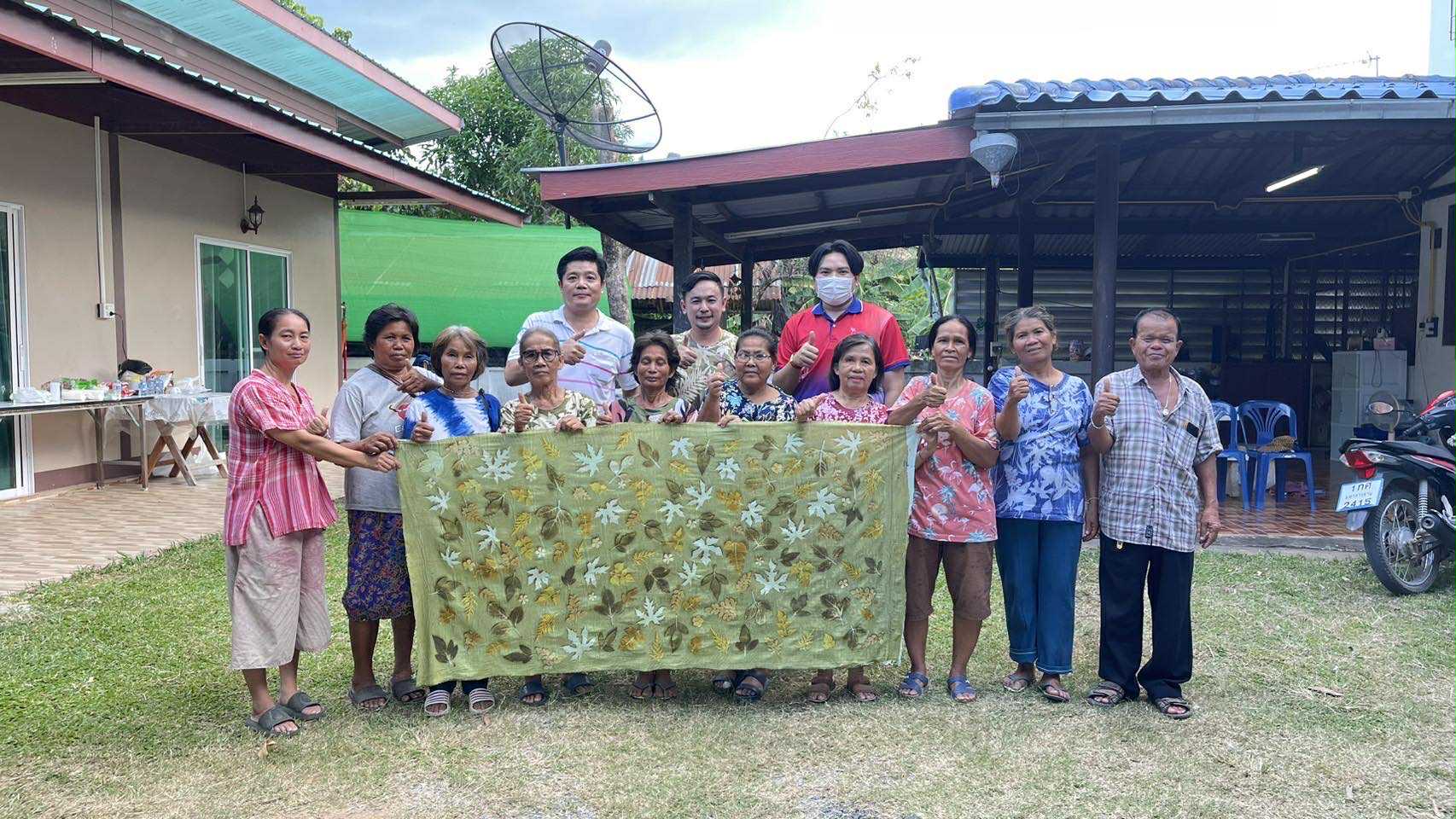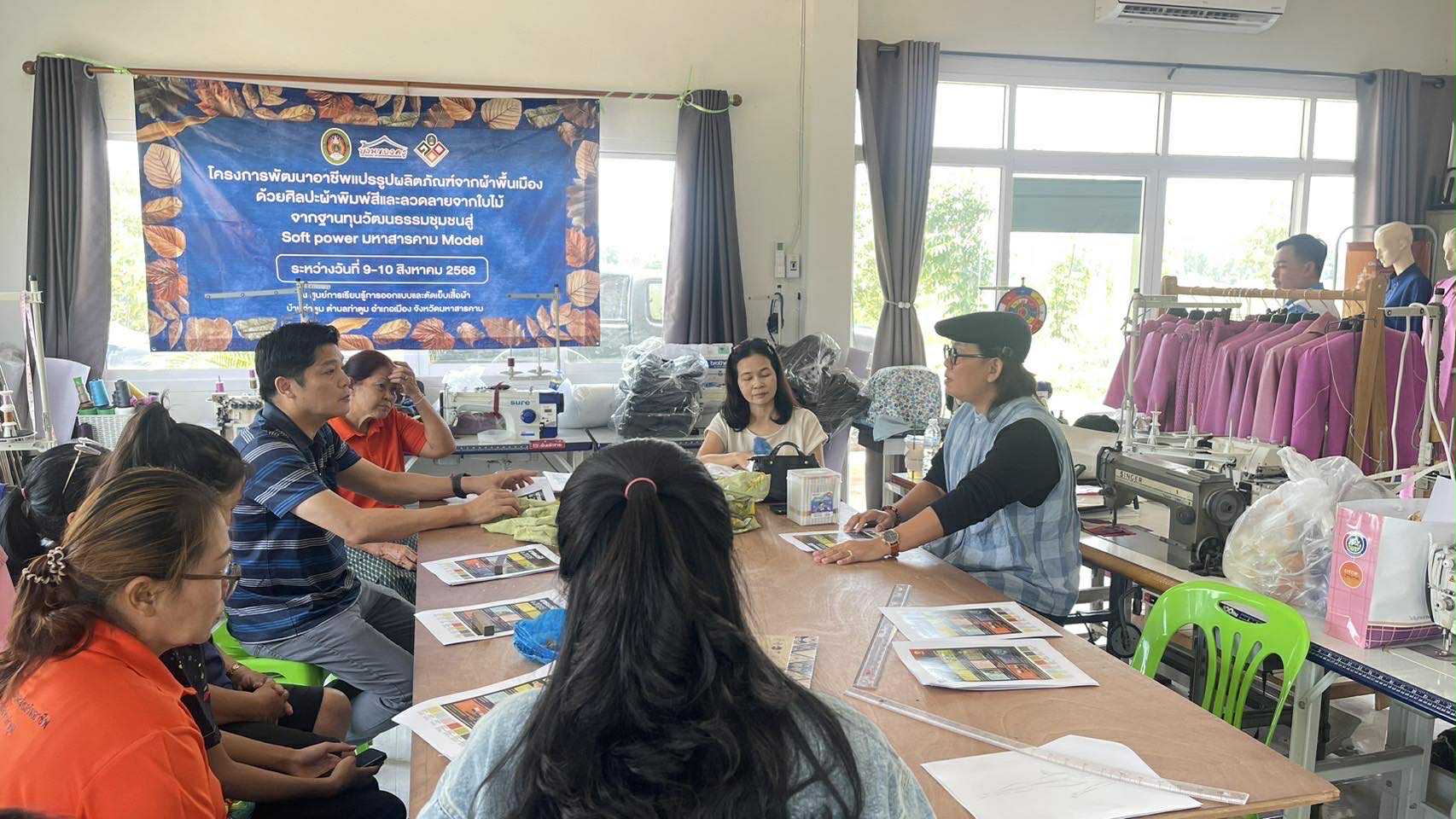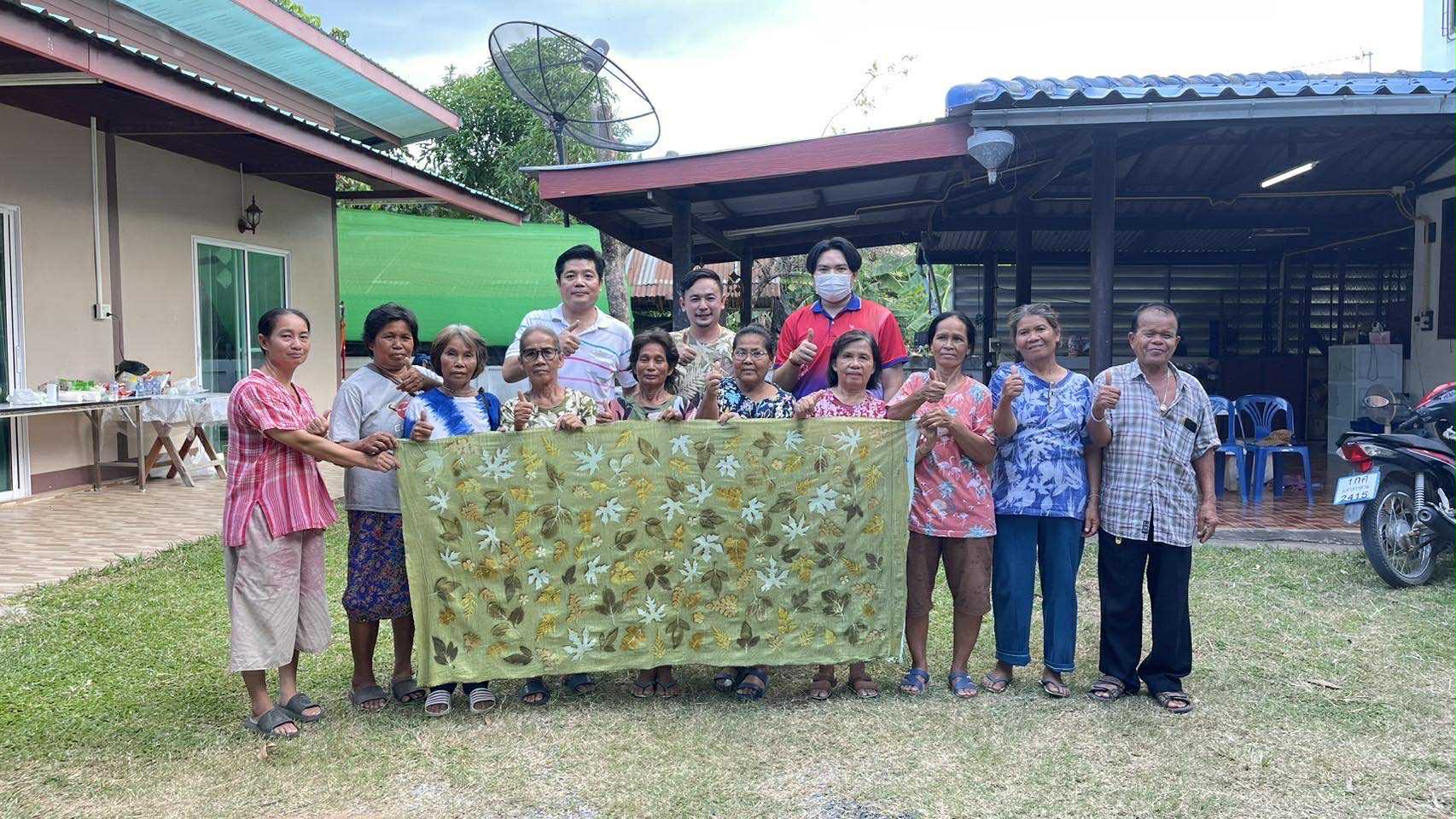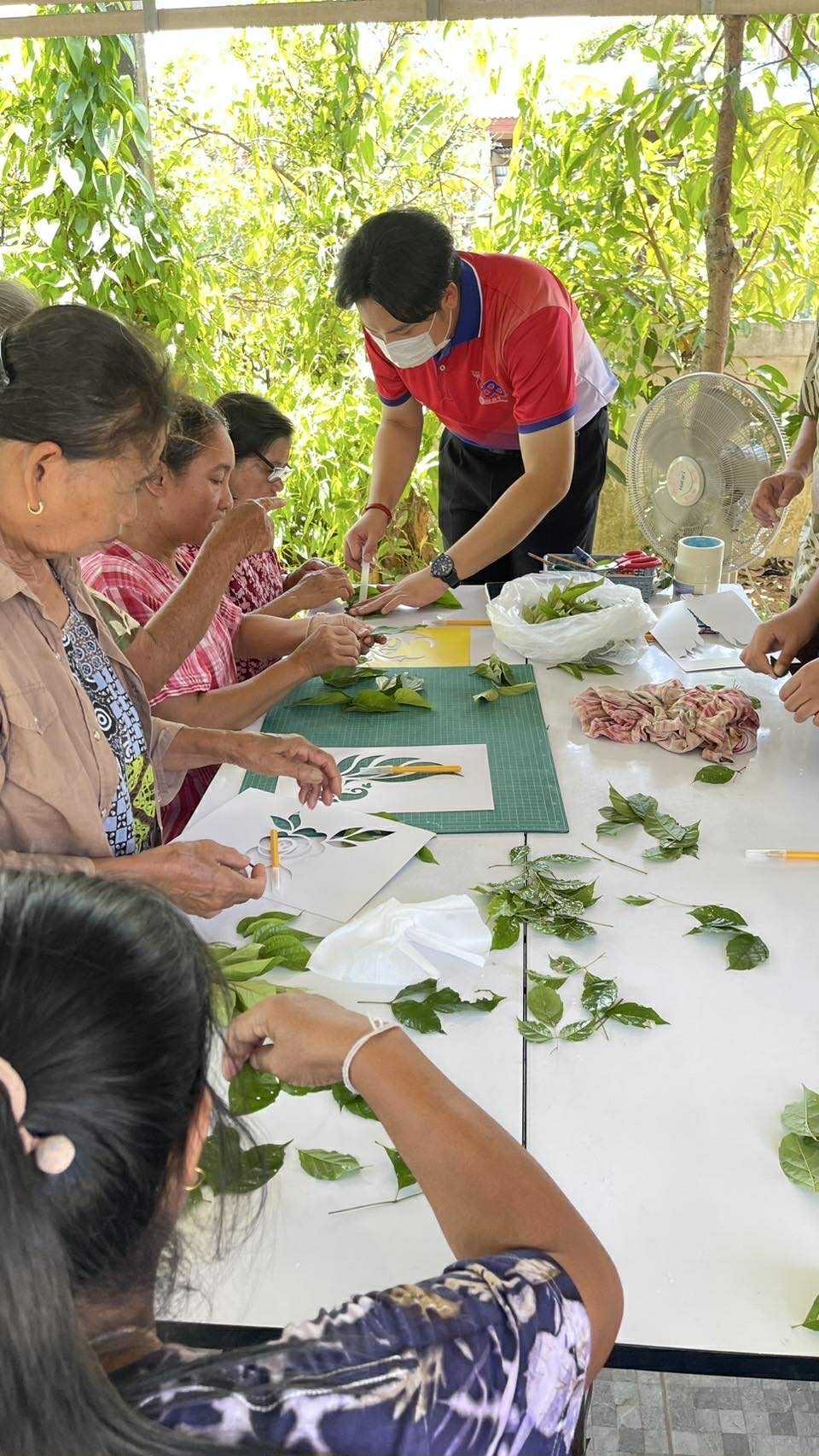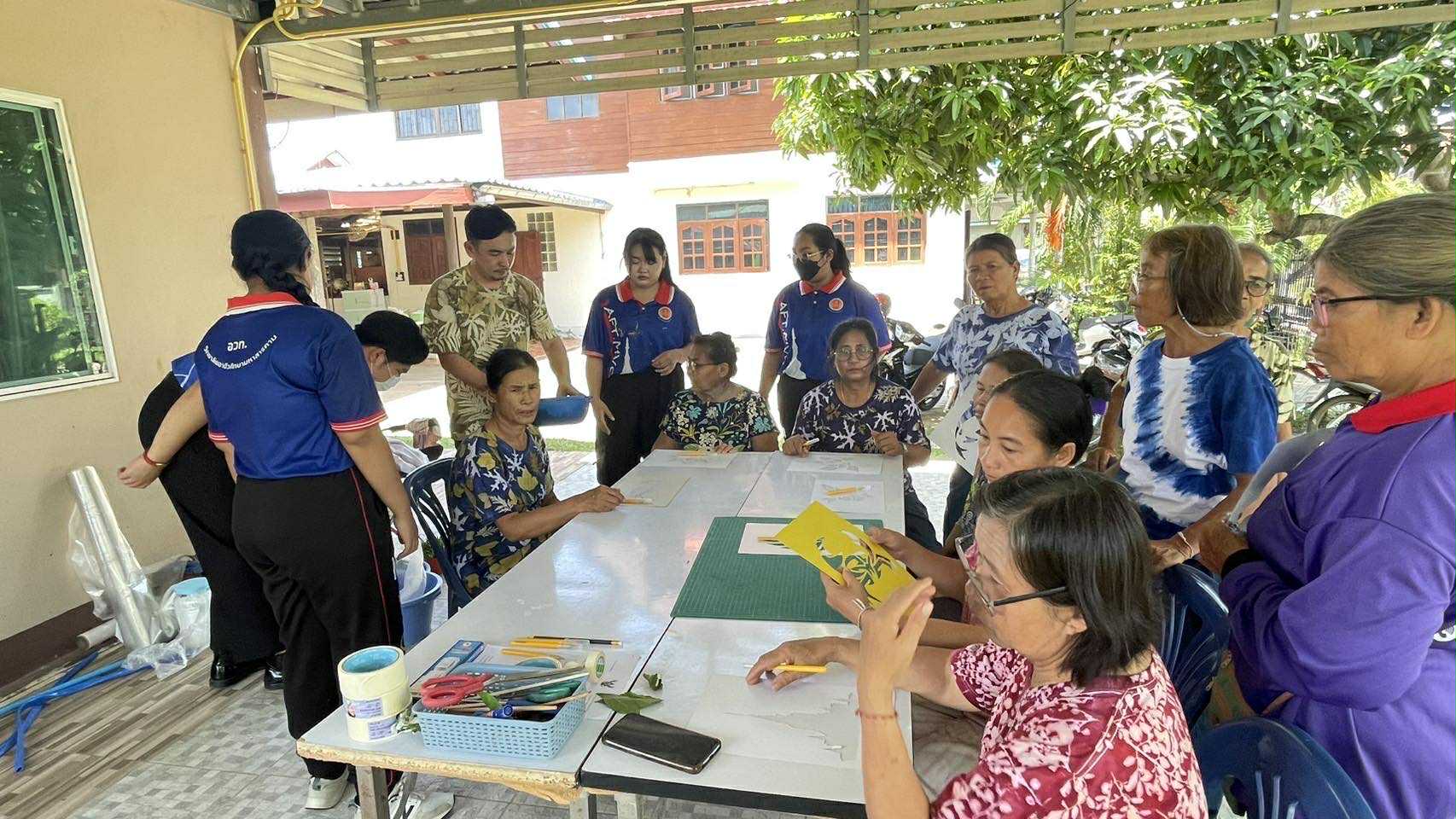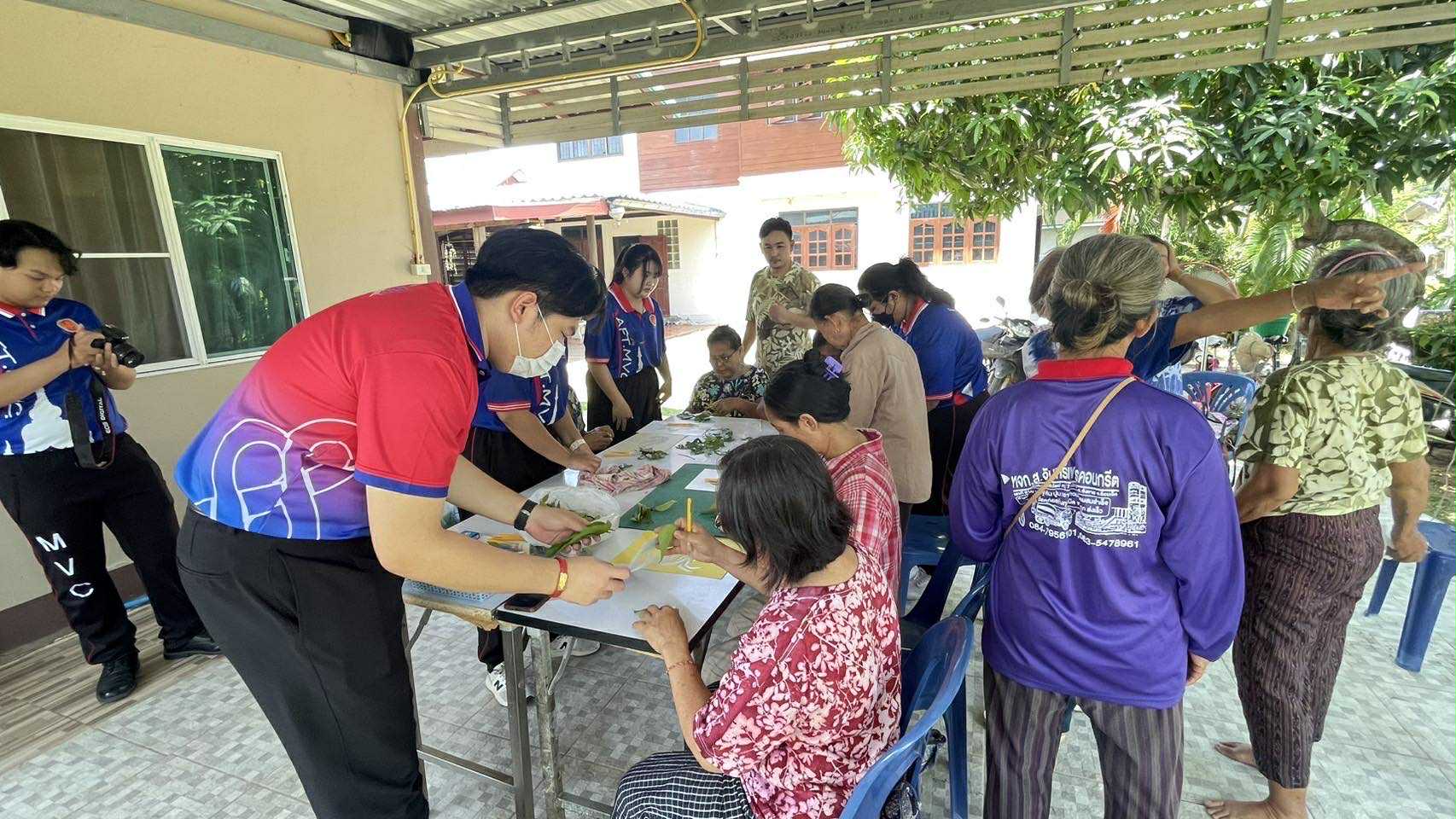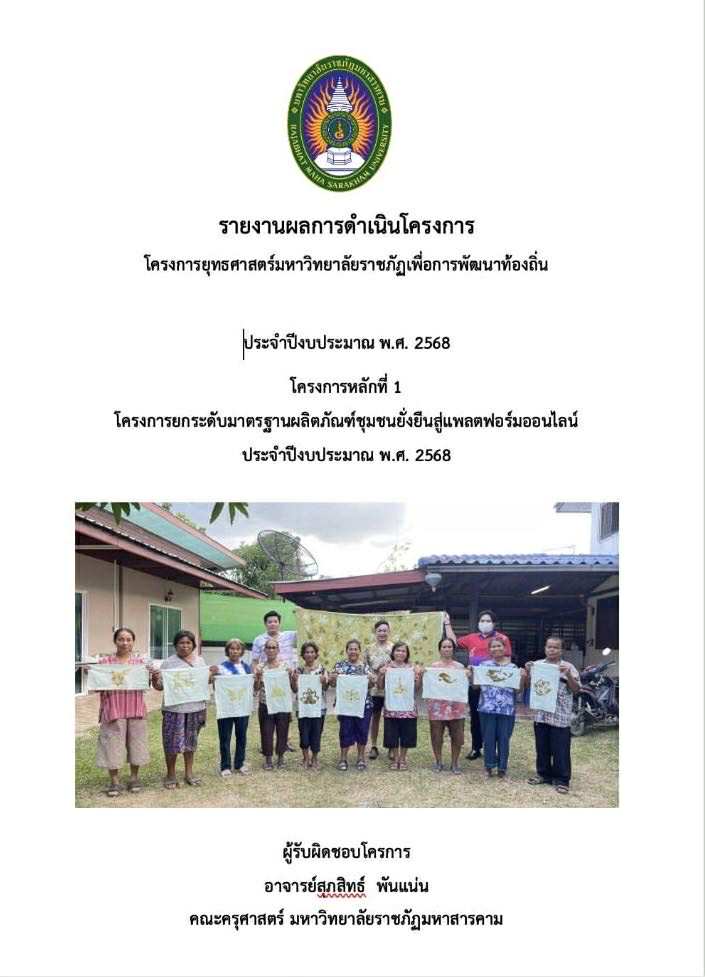
Community-Based Career Development: Processing Local Fabric Products Using Leaf-Patterned Textile Printing Art from Cultural Capital to – ‘Maha Sarakham Soft Power Model’
ผู้รับผิดชอบ ให้ข้อมูล : Suphasit Phannaen
SDG ที่เกี่ยวข้อง
เป้าหมายย่อยความสอดคล้องกับยุทธศาสตร์มหาวิทยาลัย : พันธกิจสัมพันธ์เพื่อการพัฒนาท้องถิ่นอย่างสร้างสรรค
แหล่งงบประมาณ : งบประมาณแผ่นดิน
กลุ่มเป้าหมาย : หน่วยงานภายนอก
Project Implementation Area : Tha Toom Village ตำบล Tha Tum อำเภอ Mueang Maha Sarakham จังหวัด Maha Sarakham 44000
Project Duration: August 9, 2025 – August 10, 2025
Objectives :
1. To holistically develop participants’ physical, emotional, social, and cognitive readiness, foster self-awareness, self-worth, and appreciation of their community, thereby enabling meaningful learning and skill development aligned with their potential.
2. To enhance participants’ professional skills in leaf-based fabric printing, creative product design grounded in the community’s ecosystem, product processing, marketing, and entrepreneurship, using modern innovations as a viable career option.
3. To generate sustainable income opportunities and reduce household expenses for participants according to their capacities.
Activities :
Upstream Phrase
Activity 1: Planning and Preparing the Project Team and Participants
1.1 Conduct meetings with the project team to plan and design learning activities.
1.2 Build rapport and understanding among participants to prepare them for learning and developing appropriate professional skills, as well as analyzing their own needs and challenges in entering a profession.
Midstream Phrase
Activity 2: Designing Learning Processes and Creating Learning Opportunities for Participants
2.1 Design and develop a training curriculum aligned with participants’ needs.
2.2 Conduct hands-on workshops on leaf-patterned textile printing.
Downstream Phrase
Activity 3: Developing Skills in Production, Product Processing, Marketing, and Entrepreneurship of Leaf-Patterned Textiles
3.1 Conduct practical workshops on techniques for transforming printed textiles into garments for men, women, and other products.
3.2 Summarize outcomes and extract lessons learned after project implementation.
Number of project participants: 50 people
Project Budget: 70,000 Baht
Results :
This project focused on applying the community’s cultural capital to create sustainable careers and enhance the value of local textiles, which are a significant part of the region’s traditional wisdom.
The project facilitated collaborative learning between the community, students, and faculty members, resulting in concrete professional skill development. In particular, the creative learning process through leaf-patterned eco-printing helped establish a unique identity for Maha Sarakham’s local textile products.
A key outcome of the project is that community members were able to apply the knowledge gained to actual vocational activities. They designed and produced various eco-printed textile products, including shawls, scarves, tote bags, and souvenirs that reflect local identity. These products generated supplementary income and increased economic value for households. The project also inspired younger generations to appreciate local wisdom and recognize the value of natural materials as creative resources for art and design.
Moreover, the project fostered networks and collaboration among the university, local authorities, and community groups. This collaboration enabled knowledge exchange, exhibitions, and public dissemination of the products, thereby expanding cultural impact and enhancing the positive image of Maha Sarakham as a “City of Textiles and Contemporary Folk Art.” This aligns with the Soft Power concept, which aims to promote local identity to a broader audience.
In conclusion, this project not only generated economic and career benefits but also strengthened environmental awareness, collaborative skills, and the transformation of cultural capital into a driving force for sustainable development. It serves as a model for integrating traditional wisdom with modern innovation, positioning Maha Sarakham as a Soft Power exemplary that harmoniously combines culture, art, and the creative economy.
Results society :
This project has created positive impacts on the community and society across multiple dimensions, including economic, social, cultural, and environmental aspects.
Economically, the project created new career opportunities for community members by providing knowledge and skills in producing eco-printed textiles using natural materials. Community members were able to develop value-added products such as shawls, scarves, bags, and souvenirs. This generated additional income for households, stimulated local economic circulation, and effectively reduced unemployment in the community.
Socially, the project fostered collaboration and unity within the community through intergenerational learning. Traditional local textile knowledge was transferred from older to younger generations while integrating modern artistic techniques. This promoted pride in their cultural heritage and provided a platform for villagers, students, and government agencies to jointly contribute to sustainable community development. Relationships between educational institutions and the community were strengthened, creating networks that can be expanded and applied to other areas in the future.
Culturally, the project contributed to the preservation and revitalization of local textile wisdom by combining it with leaf-patterned eco-printing techniques. The resulting products reflect the cultural identity of Maha Sarakham in a contemporary way, aligning with the Soft Power concept, which aims to promote Thai identity through local arts and crafts nationally and internationally. The project has helped position Maha Sarakham as a model area for developing a creative economy rooted in cultural capital.
Environmentally, the project encouraged the use of natural materials such as leaves, flowers, and tree bark as raw materials for creative products. This approach reduces the use of chemicals and industrial waste, raising community awareness of the value of natural resources and promoting their sustainable and efficient use.
In conclusion, the project generated positive impacts across economic, social, cultural, and environmental dimensions. It enhanced the quality of life for community members, strengthened cultural identity, and serves as an exemplary model of integrated development that harnesses cultural capital as a driving force for sustainable growth under the Maha Sarakham Soft Power Model.
Participation :
The project was successful due to the strong and active participation of students and staff from the Faculty of Education at Rajabhat Maha Sarakham University. All parties collaborated closely from the planning stage, through implementation, and to project evaluation, with the shared goal of promoting careers and enhancing the quality of life in the community by creatively integrating knowledge of arts, culture, and education.
During the preparation phase, students participated in collecting baseline community data, interviewing target groups, and analyzing cultural capital to develop career development strategies suitable for the local context. Meanwhile, staff and faculty provided guidance, planned activities, transferred knowledge on leaf-patterned eco-printing (Eco Print), and jointly designed hands-on learning processes for project participants.
During project activities, students actively worked alongside community members, performing tasks such as collecting leaves, preparing fabrics, dyeing, printing patterns, and designing products that are modern yet retain the unique characteristics of local textiles. Students also played a role in organizing exhibitions, showcasing products, and presenting creative ideas to the public, which strengthened their communication, teamwork, responsibility, and leadership skills in tangible ways.
At the same time, university staff supervised, supported resources, facilitated activities, and evaluated the learning outcomes of both students and community participants. After the project concluded, students reflected on their learning through discussions and report preparation, focusing on experiential learning and gaining deep insights into community life. Staff collected and analyzed information to serve as a knowledge base for future project development and disseminated the project outcomes in academic circles, creating a model for creative career development in other areas.
In summary, the participation of students and staff in this project not only contributed to community development but also enhanced the students’ potential to become “professional teachers” with a strong public-mindedness, social awareness, and the ability to apply knowledge to generate value for the community. At the same time, educational staff have had the opportunity to use their knowledge and experience to drive positive social change. This project serves as a prime example of integrating learning with sustainable development under the Maha Sarakham Soft Power Model, emphasizing the power of youth and the active involvement of all stakeholders in driving long-term societal progress.
Project continuity :
This project demonstrates strong potential for further development and long-term implementation, as it directly responds to the needs of the community and aligns with local development policies grounded in the Creative Economy. Its primary goal is to elevate local wisdom into value-added products, transforming cultural capital into sustainable livelihood opportunities.
The project’s continuity is evident in several dimensions. First, it strengthens the capabilities of participating community members, who have acquired practical skills in producing leaf-patterned printed fabrics. These skills can be applied in daily life and have led to collaborative product creation for sale within the community and on online platforms. This reflects the continuous expansion of knowledge and sustainable career development. Furthermore, the university has plans for ongoing monitoring and consultation to support communities in enhancing product quality and establishing a commercial brand in the future.
In terms of learning integration, the project has been incorporated into relevant courses within the Faculty of Education, enabling students to gain hands-on experience in real community settings. This will become an annual continuing activity, including advanced training, new product development, and exhibitions showcasing the achievements of both students and community members, serving as a platform for dissemination and inspiration for the preservation of local textiles.
Another dimension of continuity lies in the establishment of collaborative networks among the university, government sectors, private organizations, and community enterprises. These partnerships aim to ensure that the products meet required quality standards and are promoted as cultural items with market expansion at both provincial and national levels. Such network-based collaboration serves as a key mechanism for long-term sustainable operation of the project.
In summary, the continuity of this project extends far beyond the implementation of short-term activities. It has initiated an ongoing process of learning, development, and meaningful engagement between the academic institution and the community. The project marks the beginning of creating a cultural and creative-economy ecosystem that mutually reinforces sustainability, under the concept of the “Mahasarakham Soft Power Model,” which leverages the power of local wisdom, art, and education to empower communities toward stability and genuine pride in their local identity.
Problems obstacles :
The project was implemented to enhance professional skills, preserve local wisdom, and generate supplementary income for the community. However, the implementation faced several challenges and obstacles that affected the efficiency and continuity of activities.
The first challenge was related to participant engagement. Some participants were unable to attend all training sessions due to personal obligations, regular work, or household responsibilities. This resulted in lower attendance than planned, which reduced the effectiveness of knowledge transfer and skill development. Additionally, scheduling activities during periods that did not align with the agricultural calendar or community lifestyle caused interruptions and limited participant readiness.
The second challenge concerned resources and materials. Natural materials such as leaves, flowers, or other plants used for natural dyes were limited by seasonal availability, and some were unsuitable for fabric printing. This occasionally prevented experiments and product creation from proceeding as planned. Moreover, certain equipment was costly and insufficient for the participants’ needs, causing delays and limiting the number of products that could be produced.
The third challenge was related to skills and expertise. Although participants were motivated to learn, Eco Print techniques and pattern design require precision and continuous practice. Some participants lacked confidence in creating products, and others could not control the colors or patterns to achieve the desired results. This posed a barrier to producing high-quality products and scaling them for the market.
The fourth challenge involved marketing and product expansion. Participants still lacked knowledge and access to effective marketing channels, resulting in limited exposure of the products to the market. In addition, there was a lack of branding and packaging strategies that could enhance product value, limiting opportunities for supplementary income and broader community impact.
The fifth challenge concerned community sustainability and group cohesion. Although some groups formed initially after the project, not all were able to continue activities independently. The absence of support systems and management knowledge posed a risk to the continuity of production and marketing efforts.
In summary, the challenges and obstacles faced by this project span individual participation, resources, production processes, skills, and marketing. These issues affected the efficiency and sustainability of the project. Without appropriate corrective measures, the project may not fully achieve its goals of community development and the creation of Soft Power from local wisdom to its maximum potential.
Improvement :
The project has significant academic and social value, as it helps promote careers, preserve local wisdom, and generate income for the community. However, to enhance the project’s effectiveness and ensure its long-term sustainability, improvements and developments are needed in several areas, including project management, activity implementation, and the dissemination of results.
First, project planning should be more thorough and continuous, particularly regarding timelines and budgeting. A preparatory process for participants should be established in advance, such as introductory training on Eco Print techniques, raw material management, and basic marketing. This would provide participants with sufficient foundational knowledge and enable them to fully engage in activities. Moreover, ongoing follow-up after training is necessary to monitor progress and provide additional guidance to the community.
Second, the integration of modern knowledge with local wisdom should be strengthened. For example, digital technology can be used for pattern design, branding, and product distribution through online channels. This will help community products become more contemporary, reach a wider customer base, and compete sustainably in the market. Additionally, product packaging and storytelling strategies should be developed to create a unique identity that clearly conveys the cultural value of Maha Sarakham Province.
Third, systematic collaboration networks should be established among the university, government agencies, private sector partners, and community enterprises. Such networks would facilitate knowledge exchange, provide support for materials, equipment, and marketing channels, and strengthen the project’s capacity to expand to other communities in the future.
Finally, students and university staff should continue to play an active role through field-based learning, hands-on experiences, and further research and development. This approach will ensure that the project serves as a lifelong learning platform for both students and the community.
In summary, the project’s improvement strategies should focus on sustainability, contemporariness, and participation. These strategies will enable the development of local fabric products using leaf-patterned Eco Print to become a model for creative community development under the Soft Power Maha Sarakham Model, seamlessly integrating culture, art, and the economy in a continuous and sustainable manner.
Suggestions :
This activity reflects the university’s role in driving community development through knowledge and cultural innovation, aligning closely with the mission of Rajabhat Maha Sarakham University to be truly “a university for local development.” However, to maximize the project’s effectiveness and ensure its long-term sustainability, several recommendations are proposed for the university to guide future development.
First, the university should provide continuous support in terms of budget and resources, enabling such projects to be conducted annually. This includes practical workshops, product development, and exhibitions to showcase community achievements. Adequate funding will ensure smooth implementation, high-quality activities, and tangible results.
Second, the integration of the project with the curriculum of the Faculty of Education and other relevant faculties should be promoted, allowing students to learn through real community engagement. This can include professional experience courses, academic service-learning projects, or problem-based learning approaches, helping students gain academic knowledge, professional skills, and social responsibility.
Third, the university should develop a permanent “Local Textile and Eco Print Learning Center” to serve as a repository of knowledge, production processes, and community works. This center can also function as a training and knowledge-sharing space for students, staff, and local residents, ensuring the continuity and sustainability of the project over the long term.
Fourth, efforts should be made to expand the dissemination and promotion of project outcomes through online media, the university website, and collaborations with tourism or cultural agencies. This will enhance the university’s image as a leader in leveraging cultural Soft Power to develop the local economy and inspire other educational institutions to adopt similar approaches.
Finally, a systematic monitoring and evaluation system should be established to measure the project’s outcomes in economic, social, cultural, and educational dimensions. The data collected will reflect the project’s effectiveness and provide guidance for improving future iterations.
In conclusion, the recommendations for the university focus on ensuring the continuity of such projects, providing stable support systems, and integrating them with the institution’s core missions of teaching, research, and academic services. This approach will position Rajabhat Maha Sarakham University as a hub for driving cultural Soft Power, enhancing community quality of life, and generating positive social impacts in a sustainable manner.

